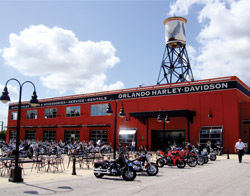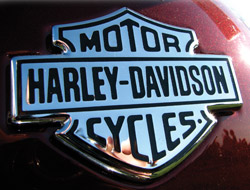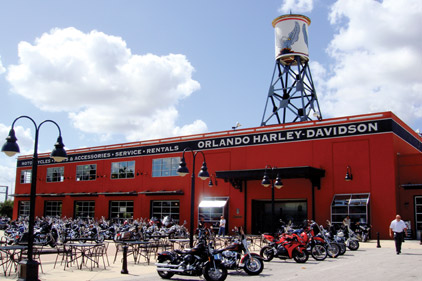
|
| Harley-Davidson stores used to look like warehouse spaces with motorcycles, but have since become showcases of unique individuality, like this one. |
Mention Wal-Mart, Amazon, or Target and watch as emotions flash across a listener’s face. Whether drawn from experience, knowledge, or the news, brands often leave impressions that are difficult to overcome. Some are positive, others negative, but either way there is something there with the ability to evoke a customer response.
That response is what many businesses are trying to protect. HVAC distributors are no exception. Each day, distribution businesses endeavor to create positive experiences for their customers all while differentiating themselves from the distributor down the street. Often there is overlap in products and services as the competition drags on and distributors can be left to wonder, “How do I keep my customers coming back?”
Rags to Riches Branding
Meet Clyde Fessler, retired vice president of business development for the Harley-Davidson Motor Co. turned motivational speaker. Fessler was a key player in the turnaround Harley-Davidson experienced after the company’s competitors began taking market share; some were imitating the product as well. That coupled with a Hell’s Angel biker-bar image made it difficult for Harley-Davidson to survive earlier on in its history.
Fessler explained the ups and downs of these tough times at Harley-Davidson to the distributors that attended one of the keynote luncheons during Heating, Air-conditioning and Refrigeration Distributors International’s (HARDI’s) 2013 Annual Conference. He encouraged attendees that even though a product can be imitated, a brand cannot. Fessler then unfolded a story of Harley-Davidson’s comeback and the key takeaways he had learned about branding that change businesses.
Three Questions in Brand Building
When it comes to building a brand, Fessler explained there were three key elements distributors should consider. All three come in the form of questions that require honest answers. The first question Fessler asked is, “Who are you?” It can be answered by looking at key services and functions of a business and focusing in on what the business is meant to be. Businesses with an identity crisis can struggle to answer this question as they endeavor to be all things to all customers.
The second question is, “Who are your customers?” Who the distributor is selling to could change the business game as well as the marketing and branding messages being considered.
The third question to ask is, “What do your customers expect?” If customers expect hands-on training with lunch and the distributor provides an instructional video without refreshments, the training service might not be viewed as productive because it wasn’t what the customer expected.
Jonathan Byrnes, senior lecturer at the Massachusetts Institute of Technology (MIT), expressed the importance of meeting customer expectations in his book, “Islands of Profit in a Sea of Red Ink.”
“Managers at different levels of your customer companies will have fundamentally different definitions of effective customer service,” he said. “Even if you make your customers’ front-line managers happy, you may still lose the executive suite.”
He goes on to explain that, “Customer service is the starting point and ending point for any effective account relationship. It is
a critical profit lever that is very often misunderstood.”
Tips to Improve Brand, Business

|
| A Harley-Davidson business tip — Promote your brand, not your product. |
Many companies already have a brand image and customer service plan in place. Here are some tips that Fessler provided to help improve brand and business performance during his presentation.
“Make your staff and customers the ambassadors of your brand,” he said. For Harley-Davidson, this meant making their dealers unique sellers who had completely bought in to the company culture.
When competition got in the way of Harley-Davidson, the company often went a different way to bypass them.
“Your business needs to be the alternative to your competitors,” explained Fessler. “Drive a wedge between you and your competition. Turn left when they go right.”
He went on to express the importance of turning negatives into positives and both for the customer as well as for the distribution business. Fessler also showed how examining why a business is not getting the sale as opposed to why it is getting sales can be eye opening into the brand and the sales process.
Challenging Management Constructs
Most businesses experience complacency in its sales and processes at one time or another. Even some of the most successful companies, like Harley-Davidson, have hit lows that seemed insurmountable. To help address this, Fessler noted how important it is to establish metrics on everything done in the business.
“If you want to change something,” he said, “measure it.”
Byrnes took a look at the challenge of change as well and he explained that, “If it ain’t broke, don’t fix it,” is one of the worst management approaches that can be taken in business.
“Leading companies are great because no matter how good they are, they are desperate to get better. Lagging companies are most often complacent and self-satisfied, that’s why they stay behind,” said Byrnes. “Every company has enormous potential waiting to be unleashed; a potential for enhanced profitability, for accelerated growth, and for renewing change. The key to achieving this potential is precise thinking and business discipline on the part of every manager, particularly those at the top.”
If Looks Could Kill
One of the fundamental changes Harley-Davidson made during its turnaround was to its stores and branches. What used to look like warehouse spaces with motorcycles lining the aisles, became showcases of unique individuality for each store.
“If your location looks like a warehouse, then customers will expect warehouse pricing,” noted Fessler. “Harley-Davidson had to enter the modern world of merchandising.”
These changes and hard work from the management and its employees helped turn around Harley-Davidson to become one of the most famous American motorcycle companies. The final ingredient to this success was the people, according to Fessler.
“People bring the passion to the business.”
Visit www.clydefessler.com or www.jlbyrnes.com for more information.
SIDEBAR: Harley-Davidson Business Tips
1. Make your staff and customers ambassadors for your brand.
2. Be the alternative.
3. Drive a wedge between you and your competition.
4. Turn left when your competition turns right.
5. Establish metrics on everything you do.
6. Turn negatives into positives.
7. Explore why you are not getting the sale.
8. Enter the modern age of merchandising.
9. Promote your brand, not your product.
10. Take care of people; they are what bring the passion to your business.
— Source: Clyde Fessler
Publication date: 2/10/2014
Want more HVAC industry news and information? Join The NEWS on Facebook, Twitter, and LinkedIn today!



Report Abusive Comment